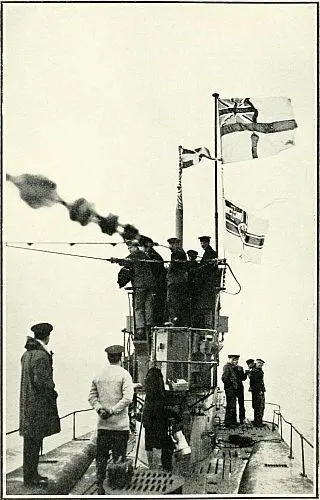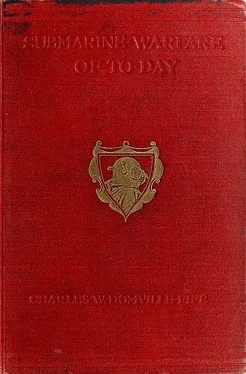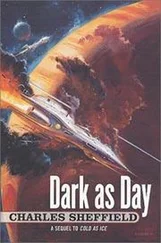SUBMARINE WARFARE OF TO-DAY
How the Submarine Menace was Met and Vanquished,
With Descriptions of the Inventions and Devices Used, Fast Boats, Mystery Ships &c. &c.,
Also Describing the Selection and Training of the Enormous Personnel Used in This New Branch of the Navy
by
Charles W. Domville-Fife
Lieut. R.N.V.R., late of the Staff of H.M. School of Submarine Mining
AUTHOR OF
“SUBMARINES & SEA POWER” “SUBMARINES OF THE WORLD’S NAVIES” “SUBMARINE ENGINEERING OF TO-DAY” &c. &c. &c.
WITH 53 ILLUSTRATIONS

British Official Photograph
The Surrender of the German Submarine Fleet
The White Ensign is hoisted over the German Eagle.
Science of To-Day
Series
NEW VOLUME
13. Submarine Warfare of To-Day.
By C. W. Domville-Fife, Lieut., R.N.V.R., late of the Staff of H.M. School of Submarine Mining. Author of “Submarines and Sea Power,” “Submarines of the World’s Navies,” “Submarine Engineering of To-Day,” &c. &c. With many Illustrations and Diagrams. Extra Crown 8vo. 7s. 6d. nett.
1. Electricity of To-Day.
By C. R. Gibson, F.R.S.E.
2. Astronomy of To-Day.
By Cecil G. Dolmage, M.A., D.C.L., LL.D., F.R.A.S.
3. Scientific Ideas of To-Day.
By C. R. Gibson.
4. Botany of To-Day.
By Professor G. F. Scott Elliot, M.A., B.SC.
6. Engineering of To-Day.
By T. W. Corbin.
7. Medical Science of To-Day.
By Willmott Evans, M.D.
8. Mechanical Inventions of To-Day.
By T. W. Corbin.
9. Photography of To-Day.
By H. Chapman Jones, F.I.C., F.C.S., F.R.P.S.
10. Submarine Engineering of To-Day.
By C. W. Domville-Fife.
11. Geology of To-Day.
By Professor J. W. Gregory, F.R.S.
12. Aircraft of To-Day.
By Charles C. Turner, Lieut., R.N.V.R.
Seeley, Service & Co., Ltd., 38 Great Russell St.
TO THE MEMORY OF
The late Lieut. WALTER PRICE, R.N.V.R.
A TRUE FRIEND AND A
GALLANT OFFICER
I desire simply to say that I commenced taking an active interest in submarines in 1904. I wrote my first book on the subject, Submarines of the World’s Navies , in 1910, and I have watched and written of the rise of these and kindred weapons for the past fifteen years of rapid development in peace and war, finally taking a humble part in the defeat of the great German submarine armada during the years 1914-1918.
C. D.-F.
1919.
While Great Britain remains an island, with dominion over palm and pine, it is to the sea that her four hundred millions of people must look for the key to all that has been achieved in the past and all that the future promises in the quickening dawn of a new era.
Not only over Great Britain alone, however, does the ocean cast its spell, for it is the free highway of the world, sailed by the ships of all nations, without other hindrances than those of stormy nature, and navigated without restriction from pole to pole by the seamen of all races. It was the international meeting-place, where ensigns were “dipped” in friendly greeting, and since the dawn of history there has been a freemasonry of the sea which knew no distinction of nation or creed.
When the call of humanity boomed across the dark, storm-tossed waters the answer came readily from beneath whatever flag the sound was heard. But in August, 1914, there came a change, so dramatic, so sudden, that maritime nations were stunned. Germany, in an excess of war fever, broke the sea laws, and laughed while women and children drowned. Crime followed crime, and the great voice of the Republican West protested in unison with that of the Imperial East. Still the Black Eagle laughed as it flew far and wide, carrying death to whomsoever came within its shadow, regardless of race and sex.
But there was an avenger upon the seas, one who had been rocked in its cradle from time immemorial, and to whom the world appealed to save the lives of their seamen. It sailed beneath the White Ensign and the Blue, and with aid from France, Italy and Japan it fought by day and by night, in winter gale and snow, and in summer heat and fog, in torrid zone and regions of perpetual ice to free the seas of the traitorous monster who had, in the twentieth century, hoisted the black flag of piracy and murder. For three years this ceaseless war was waged, and then, with her wonderful patience exhausted, the great sister nation of the mother tongue joined her fleets and armies with those of the battle-worn Allies and peace came to a long-suffering world.
In that abyss of war there was romance sufficient for many generations of novelists and historians. Many were the epic fights, unimportant in themselves, but which need only a Kingsley or a Stevenson to make them famous for all time. So with the happenings to be described in this book, many of them historically unimportant compared with the epoch-making events of which they formed a decimal part, but told in plain words; just records of romance on England’s sea frontier in the years 1914-1918.
Although jealous of any encroachment on the space available for the description of guerrilla war at sea, there are many things which must first be said regarding the organisation and training of what may appropriately be termed the “New Navy,” which took the sea to combat the submarine and the mine; also of the novel weapons devised amid the whirl of war for their use, protection and offensive power. Into this brief recital of the events leading to the real thing an endeavour will be made to infuse the life and local colour, which, however, would be more appropriate in a personal narrative than in a general description of anti-submarine warfare of to-day, but without which much that is essential could not be written without dire risk of tiring the reader before the first few chapters had been passed.
The names of places and ships have necessarily been changed to avoid anything of a personal character, and all references to existing or dead officers and men have been rigidly excluded as objectionable and unnecessary in a book dealing entirely with events.
Many of the incidents described—written while the events stood out in clear, mental perspective—could no doubt be duplicated and easily surpassed by many whose fortunes took them into zones of sea war during the historic years just past. If such is found to be the case, then the object of this book has been accomplished, for it sets out to tell, not of great epoch-making events, but of the organisation, men, ships, weapons and ordinary incidents of life in what, for lack of a better term, has been called the “New Navy”—a production of the World War.
It may be that an apology is due for placing yet another war book before a war-weary public, but an effort has been made to make of the following chapters a record of British maritime achievement , more than a narrative of sea fighting, although to do this without introducing the human element, the arduous nature of the work, the monotony, the danger and, finally, the compensating moments of excitement would have been to falsify the account and belittle the achievement.
There are many books available, full of exciting stories of sea and land war, but no other, so far as the Author knows, which describes in detail and in plain phraseology those important “little things”—liable to be overlooked amid the whirl of war—which go to make an anti-submarine personnel, fleet and base, together with an account of “how it was done.”
Читать дальше













